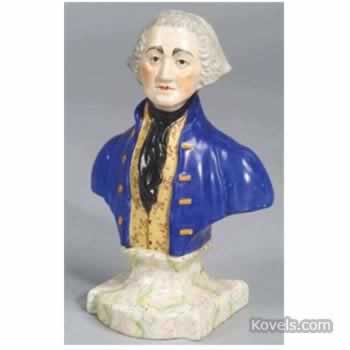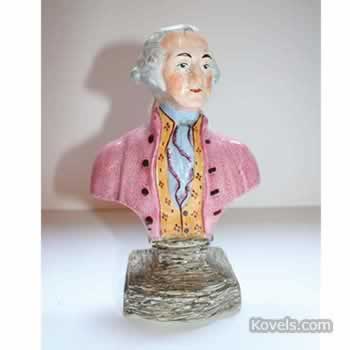English pottery figures made in Staffordshire for almost 300 years were hot collectibles from the 1970s to ʼ90s. The most popular Staffordshire figurines are dogs and important historical people. Our readers ask us how to determine if their Staffordshire figurine is authentic or a fake, a reproduction. We have gathered useful information to help decode whether a piece is real.
Many potteries are located in the Staffordshire region because of the close source of Devonshire clay, the main ingredient for most English porcelain. Some of the famous factories included Davenport, Ridgway, Rowland & Marsellus, Royal Doulton, Royal Worcester, Spode, and Wedgwood. By the late 1800s, several Staffordshire potteries were using the knot (shaped like a pretzel) as a mark. Most of these marks also include the initials of the pottery and a crown or another decorative addition. Always look at the mark on the bottom of the piece you’re considering. If you see “Made in England,” “Genuine Staffordshire,” or “Ye Olde Staffordshire,” it’s a 20th or 21st century reproduction.
The colors, condition, and details on the figure are good indicators. The colors used on this reproduction of George Washington are not as bright as the original and it also has a significant amount of crazing. If a piece of Staffordshire has a lot of crazing, it’s most likely a fake. The bottom of the bust of the authentic figure of Washington is more detailed resembling a real piece of marble unlike the bottom of the reproduction.
To learn more about Staffordshire potteries and marks, visit the Dictionary of Marks at Kovels.com and see Encyclopaedia of British Pottery and Porcelain Marks, by Geoffrey A. Godden (Barrie & Jenkins, London, 1964). The website AntiquePottery.co.uk has a page on fake and reproduction Staffordshire figures. Go to AntiquePottery.co.uk, click on “Information, and then “Fake & Reproduction.”





Leave a Reply
You must be logged in to post a comment.